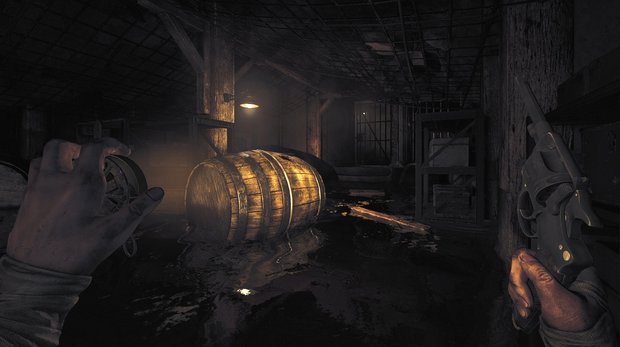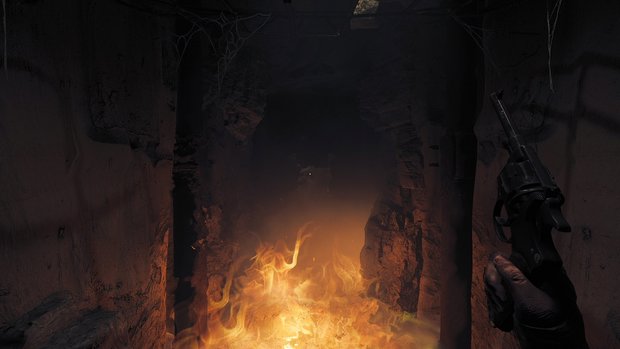Amnesia: The Bunker review

- 0 Comments
Frictional’s memorable survival horror sequel emerges as one of the series’ best
Let’s try a little experiment. Let’s say you’re a fan of Frictional Games’ massively popular Amnesia series, which made a household name for itself by being a pioneer of numerous trends that have become staples of the first-person horror genre, like a defenseless protagonist, scarce resources like light and health, and a crippling fear of the dark. Now what if I told you that the latest entry in the franchise, The Bunker, breaks many of the developer’s established molds by giving you a limitless light source, weapons to defend yourself with, limited inventory space, and a crafting system? I expect you’d say that doesn’t much sound like an Amnesia title at all. But what if I also told you that it’s one of the most frightening experiences I’ve played in quite a while, simultaneously delighting and scaring the pants off me from the word go? I hope you’ll be willing to give the differences a chance, because The Bunker is that good and will go down a treat with horror fans new and old.
Ever since The Dark Descent kicked off the series in 2010, I’ve had a huge respect for the Swedish developer and have been richly rewarded for it with one outstanding release after another, none of which have rigidly followed the formula of what came before it. The non-Amnesia title Soma is still my favorite effort from the studio for its nihilistic atmosphere and challenging narrative themes, while Amnesia: Rebirth carved out its own niche by daring to try some new ideas that also really resonated with me, albeit in a slightly different way than the original. So I was ready and eager to see where Frictional would lead me this time, and within mere seconds of the game starting, I alternated between giddy grins and slack-jawed marvel at the masterful yet familiar terrorizing atmosphere. For lack of a better way to put it, it felt like Amnesia had welcomed me back home with open arms.
War is hell; something The Bunker’s protagonist Henri Clément could tell you a thing or two about. A French soldier currently serving in the front-line trenches of World War I, Henri is about to descend into an even deeper hell. While searching for his friend, who failed to report back in after a routine patrol, Henri is ambushed by German troops and shot in the process. Sometime later, he reawakens in his bunker’s infirmary, with no memory of how he got back or what has transpired since then. But something has clearly happened, as the bunker is deserted and eerily silent, with only the occasional nearby artillery blast shaking the entire subterranean structure to keep him company.
Or at least, that is how it seems at first. The ominous blood streaks and foreboding claw marks in the walls, however, tell a wholly different and more disturbing story. It’s not long before Henri comes upon a lone survivor, gravely lacerated and at death’s door, who informs him that the officers have abandoned their men there, fleeing in blind terror from some horrifying beast and blowing up the only way out, burying it under several meters of rubble. Henri’s goal, then, is a relatively simple one: locate some dynamite and a plunger to ignite it and blast open a way out of the bunker. Sounds easy, but the reason for the officers’ flight promptly makes an appearance to snatch Henri’s lone surviving squadmate away, signaling the start of a terrifying cat-and-mouse game that you must win or die trying.

The Bunker’s gameplay loop has been pulled back quite a bit from its predecessor. Gone is Rebirth’s persistent forward progression, where the entire game was one long, albeit frightening, journey from point A to point B. Instead we’re given a hub area with four spokes surrounding it that need to be explored to enact your escape. Henri awakens in the military bunker’s central area, housing the officer’s quarters, mess hall, infirmary, and a few other rooms. This area acts as the game’s main base of operations, where you find its primary save point (there’s another one available but not until much later), an item chest for inventory overflow, a map to plan out your next course of action, and – probably most importantly – the bunker’s rickety generator.
The inventory system here is a strange beast. You are initially only able to carry six items (though there are a few inventory-expansion pouches that can be found). Assuming two slots are always filled because you’re packing a gun and flashlight – more on these shortly – that’s not much space left, which means storing anything you can’t hold in the item chest. Except that the chest isn’t bottomless either, and its set-in-stone sixteen slots fill up quite quickly, making it a fairly silly solution for dumping excess items, since anything I dropped right next to the box remained there anyway.
Crafting is really just a matter of combining certain inventory items rather than having a separate in-depth mechanic. Combining two pieces of cloth, for example, creates a bandage to heal your wounds, while wrapping a piece of cloth around a stick makes a torch to keep the bunker’s rats – who have discovered a taste for human flesh – at bay (though you’ll also need to find something to ignite it with). It didn’t take me long to figure out which items suited my play style and which didn’t, and I started prioritizing what to take and what not to needlessly clutter up my inventory with.
Before you can access the four annexed areas (the prison, the arsenal, a maintenance area, and the soldier’s personal quarters), you must find a way around the bunker’s lockdown system, which has caused heavy gates to shut off these areas for now. Some locked doors require matching keys to be found, while lockers must be opened by using a randomized number combination, scrawled onto the back of the soldiers’ dog tags you’ll find strewn around. Opening these lockers in turn provides you with a number of important items needed to proceed, like a valve wheel, a torque wrench, and so on. In essence, the game uses its hub-and-spoke setup to send players on a series of MacGuffin hunts, though many of these can be performed in whatever order you wish, while random item placement and code combinations add to the replayability.

Now, it might sound like survival would be a simple matter of powering up the gennie and running to each location to pick up whatever items are needed. But while the generator certainly provides the security blanket of a constant light source, it’s important to remember that this is an early twentieth-century wartime bunker, so this benefit is more a luxury than a lifesaver, and lights may only be placed sporadically or flicker on and off unpredictably. More than that, the generator must be fed a steady stream of fuel to function, meaning you are forced to constantly scavenge for more, necessitating frequent runs back to the hub to replenish it, sort through inventory, and save.
Of course, it’s quite possible that the available fuel burns out while you’re far away, in which case you are immediately dunked into pitch blackness, with maybe the odd red-hued emergency light nearby if you’re lucky (though this time around, there is at least no sanity mechanic to have to keep track of). Most of this game is spent in various shades of darkness, so the graphics (when we do see them more clearly) aren’t anything too special – mostly drab and dusty spaces with unimpressive furnishings, much like previous series installments – though they are never anything less than effectively creepy. An intro section that sees Henri running the trenches outside the bunker while under heavy German fire provides some nice eye candy early on, while a late-game area tips the visual scales back down again by being almost entirely shrouded in murky mist.
Fortunately, there is one more tool in your arsenal. At the game’s outset, you can find a handheld pull-string flashlight, which will shine a limited cone of light in front of you for a handful of seconds if wound up. The drawback here is that the process of winding it is incredibly loud, which – you guessed it – can be very bad for you as The Bunker’s deadly hunter responds to loud sound. Any loud sound, so discharging your weapon, setting off one of the perished soldiers’ rigged-up traps, or even quickly dashing through the bunker’s tunnels will quickly summon the creature to your location.
It's time to address the elephant in the room – er, monster in the bunker. Unlike other Amnesia games that make a point of slowly building suspense through scripted events that can’t actually harm you, The Bunker puts you in mortal danger right from the beginning, something I quickly learned the hard way. After waking in the underground infirmary, you can be attacked by the creature at nearly any time, so it’s often best to avoid making noise that will draw it toward you. To avoid spoilers, the less said about the monster the better, other than that it is a hulking shape dressed in rags that shambles at you on all fours; a mutated and demented predator. As the story unfolds, you’ll learn more about it by reading the soldiers’ own accounts of their last days and nights in the bunker.
Frictional once again shows how masterful sound design, in tandem with a claustrophobic and anxiety-inducing setting, can be used to give horror a lethal razor’s edge. Your pursuer hunts primarily by sound, moving through tunnels that spiderweb behind the walls of the entire facility like an ant colony. It can get to any point in a seeming heartbeat, and it is incredibly unnerving to hear it scrabbling toward your general location if you’ve been unwise enough to attract its attention. Once it’s sensed you nearby, it will burst from its tunnel network with an angry roar to patrol the area, and you better pray there’s a handy closet nearby to conceal yourself in when it does, or simply hunker down in a corner and hope it doesn’t look your way (running is always an option too). As the hunt becomes earnest, a frantic screeching of strings fills your ears, making the ordeal even more unsettling.
The monster’s AI seems far more persistent than we’ve seen in previous Amnesia games; it can even choose to lie in wait behind one of its tunnel exits – if you look and listen closely, it’s possible to be tipped off by the sounds of its panting and a plume of breath puffing out of the hole in the wall. While many fans will be happy about how lethal the predator is this time around, the fact that being caught by it is an instant kill also introduces the potential for quite a bit of repetition while trying to get through an area. Saving often is more important in this game than ever before. My first playthrough was on the intended ‘normal’ difficulty setting, while hardcore enthusiasts can choose an even more brutal challenge. An ‘easy’ mode is also available, but unlike the previous installment where this removed the threat entirely, ‘easy’ here means things like a few extra save points and the monster not instantly killing you on the first hit. It’s still tense and scary as hell!
You do have access to a cache of weapons, but ammo in The Bunker is ridiculously scarce; moreover, the monster can be slowed but not killed. Instead, guns, grenades, and flares are better suited to interact with the environment or help solve the physics-based puzzles. Like previous entries, the game runs on Frictional’s HPL engine, which means tons of flexibility when it comes to overcoming obstacles. Wooden door blocking your way? Break it down with a rock, blast it open with a grenade, or fire a shotgun shell at it. But objects react with each other in realistic ways, so if there’s a gas container or explosive on the other side, your solution may inadvertently trigger an unwanted (and potentially fatal) chain reaction. There’s a lot of ways to play around with the game’s moving parts, and creative players can find plenty of new approaches during repeat playthroughs.
While The Bunker marks a return to the more tightly focused scope of the original Amnesia, it is a less story-centric experience than what’s come before. The overarching series lore is still present but not really expanded upon, as Henri and the other French soldiers have little use for messing about with orbs and vitae and the like. It’s more a case where background knowledge helps to frame the events of The Bunker, though the game is well-suited as a self-contained narrative. This story, as is customary, is presented in a series of notes, letters, and journal entries, and as such is optional for those who wish to seek it out while being hunted down relentlessly. That said, it is a dark and captivating tale and tells of the unfortunate series of events that slowly but surely doomed the soldiers. By the end, even the monster’s origins are laid bare.
Final Verdict
At around five hours, The Bunker is one of the shorter Amnesia games (though it took me seven hours in total, accounting for dying and restarting several times), though the randomized elements mean it’s also more replayable than ever before. Those concerned about all the changes introduced this time around should rest assured that with The Bunker, Frictional Games has once again managed to tap back into the level of horror that made The Dark Descent so effective and beloved, and if anything dialed up its intensity. The game is harrowing, tightly paced, and manages to keep that spine-chilling Amnesia feel while strategically adding elements the series has previously shied away from, like offensive weapons and a greater focus on survival. The setting works wonders for its claustrophobic cat-and-mouse atmosphere, and the more self-contained story frees it from any existing baggage. In a word, it’s a more primal horror experience that anyone from newcomers to even the most devoted fans of its predecessors is sure to fall in love with.
Hot take
With The Bunker, Frictional has boiled the series’ gameplay formula down to its most salient and effective horror elements while trimming any excessive fat. For fans of horror, only three words are necessary: go play it!
Pros
- Grips you from the first minute and doesn’t let go
- Outstanding sound design dials up the horror
- Death and danger are omnipresent and more than just superficial this time around
- Plenty of player agency to approach obstacles in multiple ways
Cons
- Dying leads to plenty of repetition in some areas
Pascal played Amnesia: The Bunker on PC using a review code provided by the game's publisher.










0 Comments
Want to join the discussion? Leave a comment as guest, sign in or register.
Leave a comment